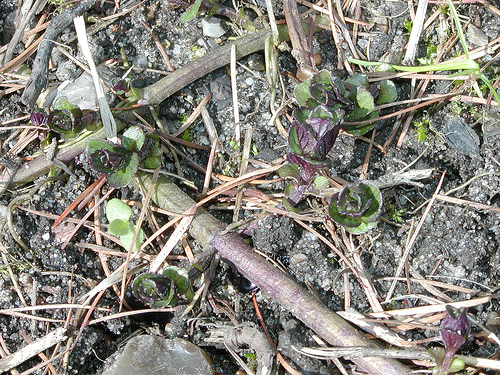Adaptations
There are a number of ways in which M. piperita adapts to the number of challenges it faces. The first and most daunting challenge that a hybrid species such as peppermint faces is obviously in reproducing. Due to the presence of a structure called a stolon, previously mentioned on the reproduction page, M. piperita has not only met this challenge, but surpassed it beyond belief. Stolons, interchangeably known as runners, are shoots from the main body of the plant that grow on top of, or just under the surface of the soil and have the capacity to develop a new plant, which is genetically identical to the parent, at the tip.
 Another structure, the rhizome, also assists in the spread and
nutrient uptake of the peppermint plant. Like the stolon, the
rhizomes are a network of specialized stem parts that branch
underground. However, instead of growing upwards and forming a
new plant, the rhizome burrows down into the earth, sending out
roots for nutrient uptake. Though their chief function is not
reproduction, pieces of the rhizome that become detached from the
main plant have the capacity to generate a brand new plant.
This technique is used most often in commercial cultivation of
Another structure, the rhizome, also assists in the spread and
nutrient uptake of the peppermint plant. Like the stolon, the
rhizomes are a network of specialized stem parts that branch
underground. However, instead of growing upwards and forming a
new plant, the rhizome burrows down into the earth, sending out
roots for nutrient uptake. Though their chief function is not
reproduction, pieces of the rhizome that become detached from the
main plant have the capacity to generate a brand new plant.
This technique is used most often in commercial cultivation of
In addition to its genetically predisposed complications, the peppermint plant thrives in climates that are above the 41st parallel. As seen in the habitat page, and sadly for the residents who also live here (myself included) this region is located nowhere near the tropics. Now, you may be asking yourself how it is that M. piperita survives subzero temperatures and several feet of annual snowfall. The answer is quite simple; it uses the snow as a blanket to protect its rootstock (the stolons and rhizomes). Just like the layer of ice that forms on the top of a lake insulates the still liquid water below and allows the fish to survive the winter, the snow does the same for the peppermint plants. When temperatures begin to rise in the spring, M. piperita benefits from the snowy covering as it melts and provides plenty of water for growth and development.
To learn about what the M. piperita plant needs to survive, check out the nutrition page! Or, go back home.